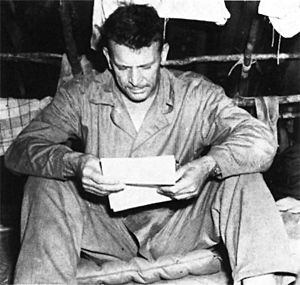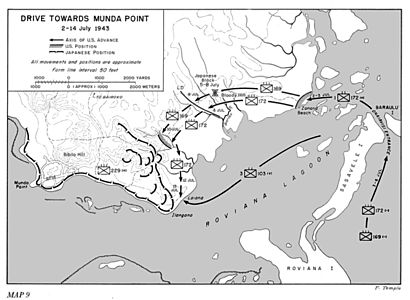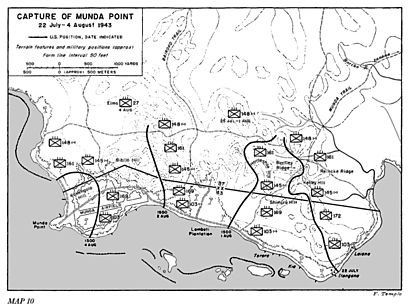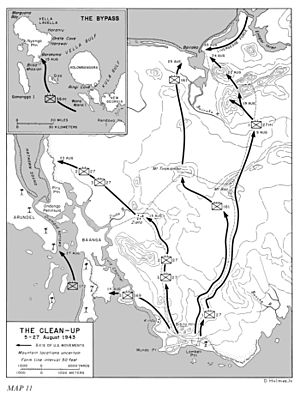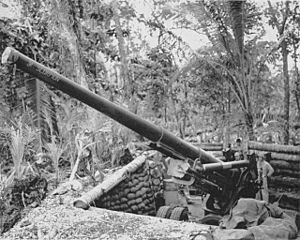New Georgia campaign facts for kids
Quick facts for kids New Georgia Campaign |
|||||||
|---|---|---|---|---|---|---|---|
| Part of the Solomon Islands campaign of World War II | |||||||
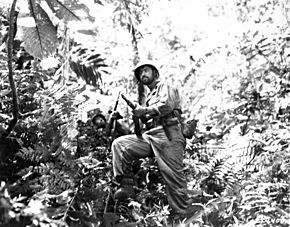 Men of the United States 25th Infantry Division push through the jungle along the Zieta Trail on 12 August 1943 |
|||||||
|
|||||||
| Belligerents | |||||||
| Commanders and leaders | |||||||
|
South West Pacific Area: |
I.J. Navy: |
||||||
| Strength | |||||||
| ~ 43,000 | 10,500 | ||||||
| Casualties and losses | |||||||
| 1,195 killed, 93 aircraft destroyed |
1,671 killed, 3,873 wounded, 358 aircraft destroyed |
||||||
The New Georgia campaign was a series of important battles during World War II. It took place in the New Georgia Islands in the central Solomon Islands. This campaign was part of a bigger plan called Operation Cartwheel. The goal was to cut off a major Japanese base at Rabaul.
The fighting started on June 30, 1943. American troops landed in several places, including Kula Gulf and near Munda. Munda was a key target because it had a Japanese airfield. The Japanese fought hard, making the American advance slow. A strong Japanese counterattack also happened. But in early August, American forces finally captured Munda Point.
Later, battles continued on Arundel Island. Many Japanese troops were on Kolombangara, but Allied forces decided to go around them. Instead, they landed on Vella Lavella in mid-August. New Zealand troops later joined them. The campaign ended on October 7, 1943. The last Japanese troops left Vella Lavella, and the Allies took control of the islands. Many naval battles also happened during this time. These included fights in the Kula Gulf and off Kolombangara.
Contents
Why the New Georgia Campaign Happened
The Japanese took control of New Georgia in 1942. They built an airbase at Munda Point. This base helped them in the Guadalcanal campaign. By late 1942, Japan knew they couldn't hold Guadalcanal. They thought the Allies would then try to capture their main base at Rabaul. The central Solomon Islands were a likely next step.
The Japanese Army thought holding the Solomon Islands would be too difficult. They preferred to wait for an Allied attack on Bougainville. But the Japanese Navy wanted to slow down the Allies as much as possible. Because there was no single command, the Army and Navy made their own plans. The Navy took charge of defending the central Solomons. The Army focused on the northern Solomons.
By June 1943, Japan had 10,500 troops on New Georgia. They also had 9,000 troops on Kolombangara. All these forces were under General Minoru Sasaki. They were ready for an Allied attack.
Allied Plans for Attack
Choosing New Georgia as a Target
In early 1943, some Allied leaders wanted to attack Rabaul directly. But Rabaul was very strong, and the Allies didn't have enough landing ships. So, a different plan was made. This plan was called Operation Cartwheel. It aimed to surround and cut off Rabaul without directly capturing it. This would happen through attacks in New Guinea and the Solomon Islands.
Japanese planes from Munda airfield often bombed the Allied base at Guadalcanal. Even after Guadalcanal was secured, these raids continued. Munda allowed Japanese planes to refuel easily. The Allies tried to stop these raids by bombing and shelling Munda. But the Japanese always repaired the airfield quickly. So, the Allies decided they had to capture Munda with ground troops.
The New Georgia Islands were in General Douglas MacArthur's command area. Admiral William F. Halsey's forces would lead the operation. About 32,000 US Army soldiers and 1,700 US Marines were sent to capture Munda. Another 9,588 troops, including New Zealanders, were assigned to capture Vella Lavella.
Capturing the Russell Islands
The Russell Islands were between Guadalcanal and New Georgia. The Japanese had used them as a staging area. Admiral Halsey decided to capture them first. This would prepare for the main attack on New Georgia. Rear Admiral Richmond K. Turner led this mission, called Operation Cleanslate.
On February 21, US Army and Marine Raider troops landed on the Russell Islands. About 9,000 troops landed with their equipment. They faced no resistance. The Japanese had already left the islands without the Allies knowing. In fact, two coastwatchers greeted the landing troops with tea!
Getting Ready for New Georgia Landings
The Japanese were worried as the Allies moved up the Solomons chain. They bombed the new American base in the Russells. They also made their airfields at Munda and Vila stronger. In response, the Americans tried to shell Munda airfield, but it didn't work well. During one shelling mission on March 6–7, 1943, American ships met two Japanese destroyers. In the Battle of Blackett Strait, both Japanese destroyers were sunk.
The Allies then tried to block Japanese supply routes by placing mines. But the Japanese easily cleared these mines. The Allies had plenty of time to plan "Operation Toenails," the invasion of New Georgia. The plan was to land troops in four places at the same time on June 30. These places were Wickham Anchorage, Segi Point, Viru Harbor, and Rendova Harbor. Rendova Island was important because it was close enough to Munda for artillery to reach.
During the campaign, British Commonwealth coastwatchers were very helpful. These brave people, often locals, watched for Japanese movements. One New Zealander, Donald Gilbert Kennedy, told villagers: "These islands are British... The government is not leaving." His safety was so important that the first Allied landings were moved up by nine days. On June 21, Marine Raiders captured Segi Point and rescued Kennedy.
Taking Over New Georgia Island
First Landings: June 30 – July 2
On June 30, US Marine Raiders and Army troops landed at Oloana Bay on Vangunu Island. They marched to Vura village, which overlooked Wickham Anchorage. By July 12, Vura was secure. Meanwhile, other Marines captured Viru Harbor on June 30. They had moved there earlier from Segi Point.
The landings near Munda were the most important. Admiral Turner led the capture of Rendova Island. About 6,000 US soldiers, sailors, and Marines landed at Rendova Harbor on June 30. They quickly defeated the small Japanese force there. Rendova, Wickham Anchorage, and Viru Harbor became staging areas for the main attack on Munda. Segi Point was turned into an airfield. Japanese planes heavily attacked Rendova, but Marines quickly built artillery positions. These guns could shell Munda airfield and support the attack.
On July 2, Americans were ready to land on the New Georgia mainland near Munda. Laiana beach was closer to Munda, but it was heavily defended. So, they chose Zanana beach, which was farther east. This choice later proved difficult. Troops landed at Zanana in daylight. They set up a small defense area before starting their slow advance towards Munda Point.
Landings in Kula Gulf
Japanese commanders wanted to keep New Georgia from falling like Guadalcanal. On the night of July 4–5, they sent 4,000 troops on destroyers down "The Slot" to Vila. From Vila, these troops would be ferried across Kula Gulf to Bairoko. Then they would march eight miles through the jungle to Munda.
The Allies also launched a landing operation in Kula Gulf that night. Admiral Halsey sent 4,600 troops, including Marine Raiders, to Rice Anchorage. Admiral Walden L. Ainsworth's ships protected the troop transports. One of Ainsworth's destroyers was sunk by the Japanese.
Colonel Liversedge's men landed successfully at dawn. Their mission was to capture Bairoko. This would cut off the Japanese supply trail to Munda. But the jungle terrain was very difficult. They advanced slowly over several days.
On the night of July 5–6, a big naval battle happened in Kula Gulf. This was the Battle of Kula Gulf. The Americans lost one cruiser, and the Japanese lost two destroyers. On land, US forces captured Triri on July 7–8. A Japanese counterattack on July 8 was stopped. Then, US troops captured Enogai on July 10–11. They then set up a block on the Munda–Bairoko trail.
Pushing from Zanana and Taking Munda
The US advance from Zanana to Munda was very slow. Difficult terrain, supply problems, and low morale caused issues. General Hester tried to break through by sending troops around to the north. But General Sasaki stopped this effort. The US advance stalled in both the north and south. The Japanese brought more troops by barge from Vila to Bairoko. More troops arrived from Rabaul on July 12–13. Admiral Ainsworth's ships tried to stop these Japanese ships. In the Battle of Kolombangara, one US destroyer and one Japanese cruiser were sunk.
Major General Oscar Griswold, General Hester's boss, visited New Georgia in mid-July. He saw the situation was bad. He told Halsey that another division was needed. Lieutenant General Millard F. Harmon confirmed the situation. Griswold then took over field command. Rear Admiral Theodore Stark Wilkinson also took over leadership of the amphibious forces.
General Sasaki used the American problems to his advantage. Japanese soldiers learned to attack American tanks up close. This made tanks less effective in the jungle. American soldiers were tired, hungry, and inexperienced. Their nerves were fraying. On July 17, the Japanese launched a strong counterattack. They even overran the 43rd Division's command post. However, Sasaki's troops also became sick and exhausted.
US forces received reinforcements, including the 37th Infantry Division. They then launched a major attack to capture Munda Point. Sasaki ordered his troops to retreat from Munda on August 3. Griswold's men surrounded Munda and shelled the remaining Japanese. On August 5, Americans entered Munda without a fight. This was the most important goal of the campaign.
Capturing Bairoko
On the northern front, Liversedge's Marines secured their position around Enogai after July 12. They patrolled the area while US Army troops held a blocking position. This position was later abandoned on July 17. Liversedge was reinforced and planned to capture Bairoko village on July 20. His Army troops would attack from the southeast, and Marines from the northeast. But the Japanese defenses were strong. Neither force made progress, and US casualties grew. On July 22, Liversedge called for air strikes to cover his retreat. This was the heaviest air bombing of the campaign so far.
Starting August 3, Liversedge tried again. He set up a blocking position on the Munda trail. On August 10, he renewed the direct attack on Bairoko. At the same time, two regiments from the 25th Infantry Division advanced on Bairoko from Munda Point. After two more tough weeks, the Americans entered Bairoko without resistance on August 24.
Securing New Georgia
The Japanese commanders at Rabaul made one last attempt to reinforce Sasaki. On the night of August 6–7, 940 troops and 700 naval personnel were sent to Kolombangara. Admiral Wilkinson, expecting this, sent six destroyers to stop them. In the Battle of Vella Gulf, the American destroyers surprised the Japanese. Three Japanese ships carrying troops were sunk. The remaining Japanese ship left without looking for survivors.
After this big loss, Sasaki moved his headquarters to Kolombangara on August 8–9. He left a small force to defend New Georgia's west coast. His new mission was to hold the remaining islands as long as possible. This would give Japan time to reinforce the northern Solomons. US Army forces moved along New Georgia's west coast, defeating the remaining 200 Japanese. On August 20–21, American troops captured Baanga islet. This silenced Japanese artillery that had been shelling Munda. The last Japanese troops on New Georgia left by barge on August 23. This marked the end of ground fighting on New Georgia.
Battles on Outlying Islands
Arundel Island Fights
Sasaki tried to delay the Allies as much as possible. When the US 172nd Infantry Regiment landed on Arundel Island on August 27, he let them land easily. But just as the Americans thought it would be simple, Sasaki counterattacked. He tied down the Americans and forced them to call for more troops. On September 15, he launched a very strong attack. This stopped the entire Allied effort on Arundel.
General Griswold ordered a full attack, including Marine Corps tanks. After fierce fighting on September 17 and 18, the Japanese left Arundel for good on the night of September 20–21.
Vella Lavella Landings
Admiral Halsey decided to bypass the heavily defended Kolombangara. Instead, he chose to invade Vella Lavella. Vella Lavella was closer to Bougainville and Rabaul and was not as well defended. A month before New Georgia was fully secured, a small Allied team landed on Vella Lavella. They gathered information about Japanese strength and good landing spots. The village of Barakoma was chosen for the landing.
On August 14, a large invasion force of about 6,500 troops, led by Major General Robert B. McClure, left Guadalcanal. Japanese planes attacked Allied bases that night but missed this fleet. The next morning, troops began landing at Barakoma.
The Japanese high command in Tokyo decided not to send more troops to the central Solomons. Instead, Vella Lavella would be used to evacuate troops from Kolombangara. Horaniu, on the northeast coast, was chosen as a barge staging point. On the night of August 17–18, a small Japanese force was sent to secure the area. Japanese and US destroyers fought an inconclusive battle off Horaniu. No ships were lost, and the Japanese set up their barge base.
Throughout August, the Allies pushed the remaining Japanese forces on Vella Lavella into a small area in the northwest. The 3rd New Zealand Division, led by Major General Harold Barrowclough, was tasked with destroying this group. The New Zealanders began their attack on September 21. The Japanese fought fiercely, and it took until October 5–6 to trap them. On the night of October 6–7, Admiral Matsuji Ijuin led Japanese ships to evacuate the remaining 600 ground troops. US destroyers tried to stop them. Each side lost a ship in the naval battle, but the Japanese successfully evacuated their troops. Barrowclough's men then entered the area without a fight, ending the New Georgia campaign.
Kolombangara Evacuation
The Japanese evacuated Kolombangara between September 28 and October 4. US forces had completely ignored and bypassed this island. The Japanese had many troops there and had fortified it strongly. But MacArthur and Halsey's plan was to only take lightly defended islands and simply go around the heavily defended ones.
What Happened After the Campaign
The New Georgia campaign resulted in many casualties. The US lost 1,195 servicemen killed and 93 aircraft. The Japanese lost 1,671 killed and 358 aircraft. Also, 3,873 US troops were wounded. Many soldiers also suffered from diseases and "war neurosis" (mental stress from combat).
The next step for the Allies in the Solomons was to land at Cape Torokina on Bougainville in November. This campaign lasted until the end of the war. Before this, there were smaller actions in the Treasury Islands and on Choiseul. In New Guinea, the Allies launched campaigns in the Markham Valley and on the Huon Peninsula.
Some historians have criticized the New Georgia campaign. Historian Samuel Eliot Morison called it "the most unintelligently waged land campaign of the Pacific war." He thought choosing Zanana instead of Laiana for the Munda landing was a mistake. He also criticized a failed flanking move during the Munda attack as "perhaps the worst blunder."






